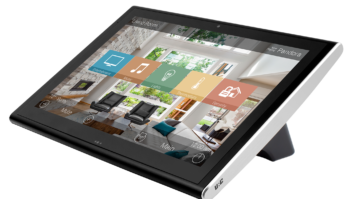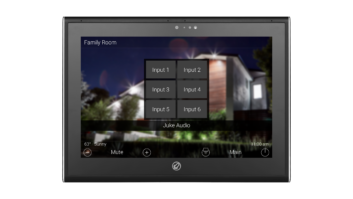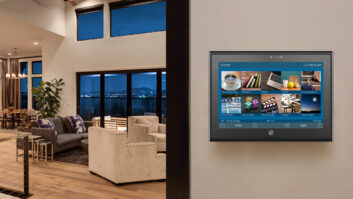Kudos: HDA-4100 offers a ton of power, flexibility, and features for both resi and commercial; HDA audio opens a world of distribution options; Offers all of the programming flexibility URC is known for
Concerns: Multiple HDA component require using an AVB switch
Regular readers might remember that I reviewed a URC Total Control system back in 2021. That review primarily focused on URC’s Total Control system as a whole, with an emphasis on the Accelerator 3 programming software, MRX-15 system controller, and TRC-1480 handheld remote with voice control.
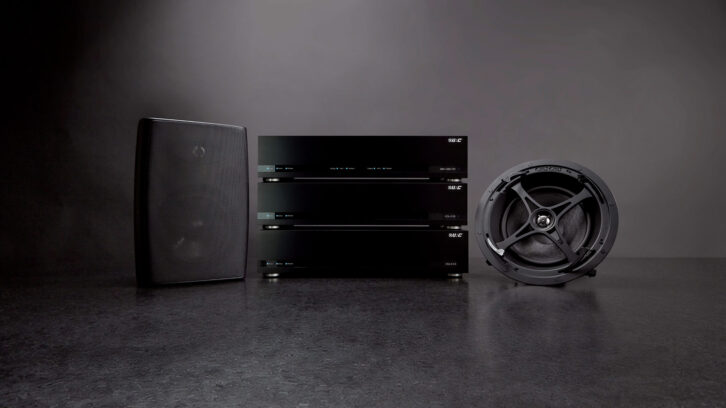
While URC included an HDA-8100 (High-Definition Audio) Multi-Zone amplifier with that review, it didn’t really get the attention it deserved, buried as it was beneath all the details of the other components. Far from being just “another 8-zone amp,” I came to learn of the many — and I mean many — advanced and flexible features the HDA amplifiers offer for both residential and commercial installs.
If commercial installs are a part of your business, or you are looking for another option in residential distributed audio along with an advanced control system and a touchscreen with built-in voice control, you’ll want to see what HDA has to offer.
Training
As mentioned in my previous review, you must be certified to sell a Total Control system, as well as to access and download the Accelerator 3 software. Certification requires attending the full Total Control training class that takes two eight-hour days. Fortunately, on top of that, URC offers extensive free online training, videos, programming guides, and integration modules for many of its control drivers, along with live virtual training to ensure dealers can get the most out of systems.
As this was my second go-round programming in URC’s Accelerator 3 software, I was a bit more comfortable with the process of commissioning the system, configuring the audio zones of the HDA, and downloading, installing, and activating the control modules for my HEOS audio system, Hunter Douglas PowerView shades, and DISH Hopper. I also viewed a ton of URC’s online training sessions specifically about programming in Accelerator, creating and adding custom graphics, and availed myself of URC’s extensive HDA Programming guide that walks you through each step of setup and configuration of the HDA amplifiers. Plus, I was able to lean on URC’s senior sales engineer, Shawn Stermer, when I ran into something I needed help with. Even still, I’ve no doubt I’m just scratching the surface of what Total Control systems are truly capable of, and would definitely say the full training course is a worthwhile investment.
For programmers that like living fully outside the sandbox and getting into full and total customization, URC also offers a version of its software called Flex. With Flex you literally create every background, button, and graphic in a project, as well as manually create every bit of programming.
To help alleviate the cost of bringing in a demo system, URC has a provision where a dealer can “earn” their demo kit by selling two systems during a specified period. You can’t really ask for a better “try it, you’ll like it!” offer.
HDA Family
There are currently five components in the HDA family, and they are designed to address different needs for audio distribution across projects of nearly any size — it supports up to 32 inputs and 32 outputs — allowing you to remotely add sources and zones as needed while still having them accessible across the entire system.
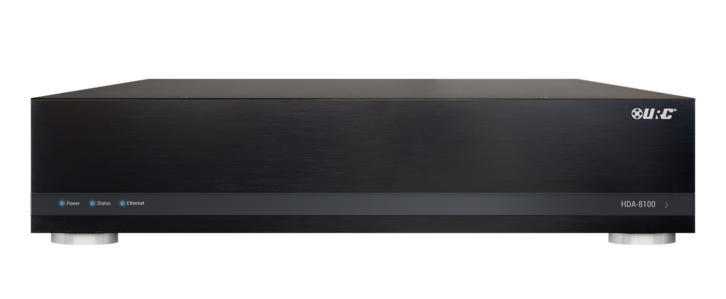
For perfectly synced high-quality distribution, the HDA line-up uses AVB (Audio Video Bridging) to route digital audio signals up to 96 kHz/24-bit resolution with zero loss or latency around a home, and if there are more than one HDA component on a project, you must use an AVB-compliant switch, such as URC’s HDASW5, which isolates the audio stream traffic.
The amps that resi installers will most likely use will be the HDA-4100 and HDA-8100, which are similar in size and performance but differ in capability with the 4100 being a 4×4 matrix amplifier and the 8100 an 8×8. Both models feature powerful ICEpower digital amplification to deliver big output while remaining cool and delivering reliable operation. These are both capable of delivering 100 watts into 8 ohms or 200 watts into 4 ohms to all channels, but offer the flexibility of being able to split any stereo zone into two mono zones. Stermer said each channel is stable down to 2.7 ohms, meaning it would be capable of driving three 8-ohm speakers in parallel; thus a 4100 could drive an 8-zone mono system with a total of 24 speakers! That’s a ton of capability at its price point.
Additionally, both models feature two 12-volt triggers and two sets of assignable RCA pre-outs that are great for feeding a local home theater zone or driving a powered subwoofer in a zone. The 8100 adds two coaxial digital audio inputs that can downmix a Dolby or DTS 5.1-channel signal to stereo for playback.
Commercial installers will glom onto the HDA-1600. This flexible beast can deliver 600 watts into 8 ohms or 1200 watts into 4 ohms in single stereo or dual mono, or 600 watts in 70-volt, and it can simultaneously drive 4/8 ohm and 70-volt loads, with the amp automatically determining the speaker type and output power accordingly, so there’s no worry of damaging a speaker. Besides four RCA analog inputs, there is a set of balanced XLR connections that can be another stereo audio input or two mic inputs, including 12/24/48-volt phantom power supply and built-in noise suppression. There is signal sensing on the mic inputs that can be programmed to automatically go into paging or ducking for announcements via mic (or analog) audio inputs.
The HDA line also features two very cool and compact “problem solvers” about the size of three stacked CD jewel cases in the form of the HDA-I/O and HDA-130. The I/O is a compact input/output device with both inputs and outputs in Toslink, coaxial, and RCA stereo that can either create or decode a single stream and can power via PoE. The HDA-130 is a compact little amplifier that delivers 2 x 30 watts (stereo or mono) to remotely power a single zone, as well as having coaxial, optical, and analog inputs to create an additional audio zone for the system. It also has a summed preamp output to connect to a local powered subwoofer for full-range audio. The 130 can be locally powered via 48 VDC or via PoE++.
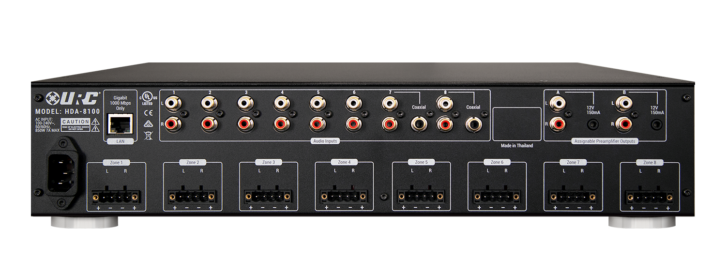
Each HDA component offers loads of configuration within the Accelerator software, letting you adjust source input levels, create permanent zone groups, set any zone to mono, adjust high- and low-pass filters, lip-sync correction, active limiters and compression, tone shaping, and even a 5-band parametric EQ setting to dial in the audio for each zone.
Further, each amp can store up to 10 WAV files that can be used in any zone. These can be triggered, set up in a timer or clock event, or placed into a macro and used for notifications, announcements, doorbells, alerts, etc. With the unit’s audio ducking and paging, it can override or play over whatever is currently playing, and the percentage of audio drop, fade timing, duration, and fade back into music are all programmable.
To speed up testing, commissioning, and calibration, you can connect to any zone in real time for testing, giving you access to white, pink, and brown noise generator, and also letting you test parametric EQ and tone-shaping settings and filters without needing to download to the system first.
Installation
For a working system, you need an amplifier, a controller, and an interface. URC sent the MRX-15 advanced processor, the HDA-4100 multi-zone amplifier, and the TDC-8600 in-wall touchscreen controller. As much as I’d have liked to have played with the HDA-1600, I just didn’t have the means to connect it to anything to test it.
The MRX-15 processor offers a ton of connection options, facilitating connection for nearly any system. Beyond hardwired Gigabit Ethernet for network control, there are eight 3.5mm IR ports with variable output, two configurable relays, two configurable 12-volt outputs, four 3.5mm RS-232 ports, and four 3.5mm sensor ports. The sensor ports are kind of unique to URC and really create another great way to add reliability and customization to your install. With the variety of URC sensors — audio, contact closure, current/magnetic field, light, video, and voltage — you can detect a change in state and then have the system respond to that. For example, a sensor could detect an audio stream starting from a connected media player and then automatically turn on the audio system.
While URC is likely best known for its line of handheld controllers, these are rarely used in commercial environments, so the company sent its new TKP-8600 8-inch in-wall touchscreen with integrated Amazon Alexa voice control and a 5MP camera. This powers via PoE+ and can install either portrait or landscape, and URC even offers a flush-mount mounting kit for a cleaner look.
For additional control, you can add as many iPhone/iPad and Android Phone/Tablet drivers into the project as desired and utilize URC’s Mobile 2.5 app for control. These can be PIN protected, linked to open to a specific room, or even pared down for a guest experience.
I connected four rooms of my existing house-wide audio system to the HDA-4100, along with analog audio connections from my HEOS Link and DISH Hopper. I used one of the sets of analog outputs to feed a powered subwoofer in my kitchen zone. While it’s a simple thing, I do like how the speaker Phoenix connectors can screw into the chassis, making sure that they can’t accidentally slip out.
While the system doesn’t have any built-in streaming services, it works with a variety of popular hardware solutions such as Fusion, HEOS, Sonos, and Autonomic, allowing you (the integrator) to use your preferred solution. There are also a variety of two-way modules that will provide not only full control and metadata, but also album artwork on all of the interfaces.
Of course, the majority of a control system installation involves programming and commissioning the system, which is where the Accelerator 3 — URC’s latest version of Total Control software — comes into play. The company calls this “the shortest route from concept to completion.”
If you’ve ever poked around URC’s database, you’ll know it is packed with thousands of IR drivers, supporting a huge array of equipment going back many years. Total Control ups this ante by adding a significant number of RS-232 and IP databases to Accelerator, along with additional drivers and modules you can download from the company’s portal. In short, it’s likely that URC will interface with your preferred subsystems. Further, if your preferred driver isn’t available, you can create an IR, RS-232, or IP driver to fit your needs.
I liked that when you finish programming or making any changes, you can download to any or all URC devices simultaneously, meaning if you just made a minor change, you only need to update that single device. Also, Accelerator does a really handy job auto-creating many of the macros and power management commands for you, keeping you from having to do some of the menial programming. Also handy is that any macro created by Accelerator can be converted to an Alexa skill, quickly cutting down on some further programming.
Rest assured you can still heavily customize the programming and layout, adding any button to any screen and tweaking the programming and layout to perfectly fit your customer’s needs, as well as adding customized graphics for backgrounds and room images to further personalize the project. And URC’s MCS remote accessing tool allows you to check on a project’s status, upload programming changes, check system health and history, force a reboot, and more. This requires a small bit of work to activate — along with the homeowner providing consent — and you have to be onsite to enable this capability for the first time.
In Use
A distributed audio system’s primary purpose for existing is to enable a user to quickly and easily access and control music, and here the system performed exactly as intended. Using either the mobile app or touchscreen, it was simple and intuitive to get music playing in any room and then link and unlink rooms if desired. Also, a simple “Party Mode” macro could give you a quick one-button touch to link the same music in lots of areas at once, which would be perfect for commercial spaces.
The 8600’s vibrant display has enough real estate to let you quickly check the status of each zone to see what is playing and if it any zones are linked, as well as providing handy information such as a three-day weather forecast and a scrolling list of info in the lower corner including the current weather and sunrise and sunset times. I also liked that it has a proximity sensor that can be enabled to automatically turn on if someone approaches it, or that you can have the screen remain totally dark until it is activated, which is perfect for a bedroom.
Having Alexa built into the panel also opens a host of hands-free options, along with all of the voice programming that can be enabled in Accelerator. The panel’s three-mic array was also very sensitive for picking up commands and should work well in a noisy commercial environment. Don’t want to use Alexa or have it wake up every time some joker at the bar wants to talk to it? You can disable Alexa completely or have the microphone only respond when the button is pressed. It also has a built-in 5MP camera that can be used for room monitoring or for video intercom calls.
Having access to the lip-sync adjustment right in the app was also quite handy, letting me dial in the audio from my DISH Hopper in relation to the audio in my living room, getting it in perfect sync. URC also has a ton of great audio modules for HDA, letting you quickly check source status and volume level of all zones, check the amplifier’s real-time thermal conditions, or see if it is peaking, as well as a great multi-display control module that would be perfect for sports bars.
The 4100’s amplifier was plenty potent, easily coaxing enough volume and bass from my in-ceiling speakers. Large speakers, like the 10-inch Origins in my dining room, definitely benefit from the generous amounts of power. If anything, I’d say that it could lean toward sounding a bit forward at higher volumes.
From my previous review, I remember the HDA-8100 having fairly noticeable fan noise. URC issued a firmware update about a year ago to address this, decreasing the fan noise on all HDA models by about 10 dB, and I’m happy to say that the 4100 was virtually silent in operation and certainly never called attention to itself.
While it is possible for the end-user to remotely access and control their home with the mobile app, doing so does require setting a static IP or dynamic DNS server for the home, and then setting up port forwarding in the router.
Now, I’ll be honest, my company bleeds resi; we almost never dabble in commercial work beyond the occasional TV or projector hang in an office or conference room. So, to get some perspective on how HDA serves the commercial space, URC put me in touch with John Carroll, CTO at Nard’s, Inc., located in the Virginia/DC area; a company that has been around since 1972 and strictly does commercial installs.
Carroll said that the step-up MRX-30 is their controller of choice, as it allows them the flexibility and futureproofing of being able to return and expand a system over time. He also commented that HDA allows them to install music systems without needing a separate DSP, since the HDA amplifiers are flexible and powerful enough to deliver the features customers want and need, “giving you a custom DSP feel without needed to put a ton of time into programming.”
When installing systems in amenities spaces that have two and three conference rooms that can be individual or combined, Carroll related the HDA platform gives the flexibility to go and change things like being able to mono the outputs and take an 8-channel amplifier and make it into 16 channels. And commercial music systems need to be able to offer ducking and paging features for things like waiting rooms, offices, and restaurants, which HDA has built-in.
Carroll’s go-to panel is the TKP-8600, and he loves that the Accelerator software cuts down on programming time, while still offering a ton of flexibility. “My thought process is, ‘How am I going to lay out the interface for this room? How can I get the user interface I want to achieve with the fewest number of buttons for the user?’ and then I work back from that,” he says. “URC makes it easy and intuitive for the end user, but restricts you from going overboard on your programming with too many buttons.”
URC has long been known for its powerful single-room solutions, and Total Control expands that into whole-home and commercial space with far more powerful MRX-series controllers. The HDA audio lineup offers a lot of unique and powerful audio distribution options, letting you easily cover a large home or commercial space, with powerful DSP features on-board that can either be used for extracting the best sound out of a space or easily integrating paging and announcements — or both! As URC likes to say, “HDA is flexible enough for residential, but designed from day one for commercial.”
https://www.urc-automation.com; 800-901-0800
Product Specs:
- Total Control systems available to authorized dealers; requires Accelerator programming software
- MRX-15 Advanced Network System Controller: Designed for large residential projects; stores and issues commands for all IP, IR, RS-232, Relays, Sensors, and 12-volt trigger-controlled devices; requires hardwired network connection
- HDA-4100 multi-zone amplifier: Powers up to 4 stereo, 8 mono, or any combination of audio zones with 100/200 watts/channel (8/4 ohms) ICEpower; 4 sets RCA stereo analog audio inputs; two sets RCA preamplifier outputs; two 12-volt mini-jack triggers; Gigabit LAN connection; detachable power cord
- TKP-8600 8-inch (1280×800) in-wall touchscreen controller with integrated Amazon Alexa Voice Control: Supports audio/video intercom calls across supported devices as well as door station integration; Cortex-A9 QuadPlus 1GHz microprocessor; hardwired Gigabit PoE+ network connection; portrait or landscape installation
- URC Mobile 2.5 control app for iOS and Android devices: Remote access requires static IP or dynamic DNS setup
Dimensions:
- MRX-15: 83 x 2.03 x 8.3 inches (WxHxD); Weight: 4.61 pounds
- HDA-4100: 25 x 3.5 x 12 inches (WxHxD); Weight: 11 pounds
